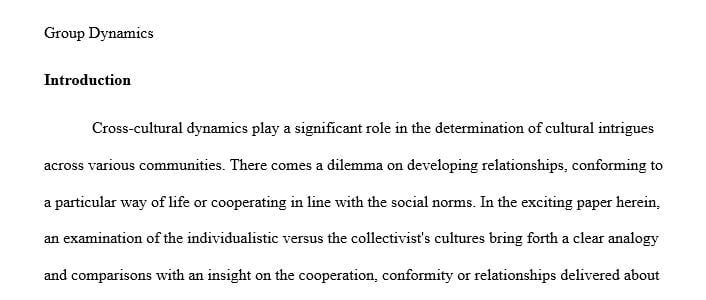Explain how group dynamics might differ between an individualistic culture and a collectivist culture
A brief description of a problem-solving group situation. Then, explain how group dynamics might differ between an individualistic culture and a collectivist culture.
Include in your description how conformity, cooperation, or group relationships might manifest themselves in different cultures. Justify your response with current literature. Consider the group dynamics in individualistic and collectivist cultures.
Here are the required headings:
Situation Described
Contrast Group Dynamics (address conformity, cooperation, or group relationships)
Insights
References-use and cite only my sources below.
Course Text: The Handbook of Culture and Psychology
Chapter 18, “Cross-Cultural Studies of Social Influence”
Article: Briley, D. A., Morris, M. W., & Simonson, I. (2005). Cultural chameleons: Biculturals, conformity motives, and decision making. Journal of Consumer Psychology, 15(4), 351–362.
Retrieved from the Walden Library using the Academic Search Complete database.
Article: Cinnirella, M., & Green, B. (2007). Does ‘cyber-conformity’ vary cross-culturally? Exploring the effect of culture and communication medium on social conformity. Computers in Human Behavior, 23(4), 2011–2025.
Retrieved from the Walden Library using the ScienceDirect database.
Article: Costigan, C. L., Bardina, P., Cauce, A. M., Kim, G. K., & Latendresse, S. J. (2006). Inter- and intra-group variability in perceptions of behavior among Asian Americans and European Americans. Cultural Diversity and Ethnic Minority Psychology, 12(4), 710–724.
Retrieved from the Walden Library using the PsycARTICLES database.
Article: Hallenbeck, J. L. (2004). Communication across cultures. Journal of Palliative Medicine, 7(3), 477–480.
Retrieved from the Walden Library using the Medline With Full Text database.
Article: Kaplan, S., & Cunningham, C. (2010). Eight quick tips for improving global cross-cultural communications. Diversity Factor, 18(2), 33–38.
Retrieved from the Walden Library using the Academic Search Complete database.
Article: Nibler, R., & Harris, K. L. (2003). The effects of culture and cohesiveness on intragroup conflict and effectiveness. The Journal of Social Psychology, 143(5), 613–631.
Retrieved from the Walden Library using the ProQuest database.
Article: Rhee, S., Chang, J., & Rhee, J. (2003). Acculturation, communication patterns, and self-esteem among Asian and Caucasian American adolescents. Adolescence, 38(152), 749–768.
Retrieved from the Walden Library using the Academic Search Complete database.
Article: Sanchez-Burks, J., Lee, F., Choi, I., Nisbett, R., Zhao, S., & Koo, J. (2003). Conversing across cultures: East-West communication styles in work and nonwork contexts. Journal of Personality and Social Psychology, 85(2), 363–372.
Retrieved from the Walden Library using the PsycARTICLES database.
Answer preview to explain how group dynamics might differ between an individualistic culture and a collectivist culture

604 words

